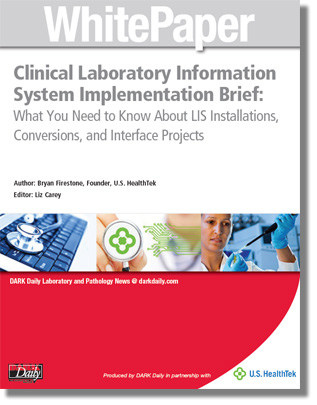
Clinical Laboratory Information System Implementation Brief: What You Need to Know About LIS Installations, Conversions, and Interface Projects
 A recent LIS market report shows that demand for a modern LIS is driven by a number of factors: acceleration of laboratory automation, the need for improved lab efficiency, advances in integrated functionality, importance of compliance with regulatory requirements, and the rising prevalence of chronic diseases.
A recent LIS market report shows that demand for a modern LIS is driven by a number of factors: acceleration of laboratory automation, the need for improved lab efficiency, advances in integrated functionality, importance of compliance with regulatory requirements, and the rising prevalence of chronic diseases.
Indeed, because all laboratories are now routinely being asked to do more with less, these and numerous other urgent reasons are compelling independent and hospital laboratories to invest resources in a major laboratory information implementation or upgrade.
Dark Daily is pleased to offer a new FREE White Paper providing practical insights and indispensable how-to’s regarding the enormous challenges associated with installing, converting, and interfacing a laboratory information system. This paper, written by an expert who has experienced (and overcome) these challenges, outlines for you a multi-step plan for bringing your laboratory team together toward the common goal of a modern LIS, thus expanding your lab’s capabilities, ensuring efficient operations, and yielding quality improvement.
This White Paper specifically addresses:
- Questions to ask when researching a laboratory information system
- Finding the right project manager who will mesh well with your laboratory and put into place the steps necessary to make your LIS installation or conversion a success
- Building a realistic budget for your project, including important considerations not directly related to your implementation
- Events important to include in your project plan that are often overlooked
- Reasons, many not obvious, for eliminating as many variables, non-essential tasks, and complicated workflows as possible—pre go-live
- And much more!
Table of Contents
Introduction
Part 1: Components of a Clinical Laboratory Information System Implementation
Phase 1: Project Initiation, LIS Preparation, Gap Analysis, and New Software
Phase 2: Installing the Laboratory Information System, Configuration, Data, Interfaces
PART 2: Critical LIS Testing and Parallels: Can We Achieve a ‘Non-Event’ at LIVE?
Phase 3: Laboratory Information System Testing and Training
Phase 4: Laboratory Information System LIVE and Support
Key Takeaways
The right LIS is key to your laboratory’s quality operations. And when it comes to LIS installations, conversions, and interface projects, there are a multitude of issues to consider. Achieving the successful implementation will not only streamline your laboratory processes, it will also provide the added benefits of improved staff morale and stronger relationships with your clients and investors.
As a member of your laboratory’s leadership team, learn what you need to know during every phase of LIS change —download your FREE copy of “Clinical Laboratory Information System Implementation Brief” below!




